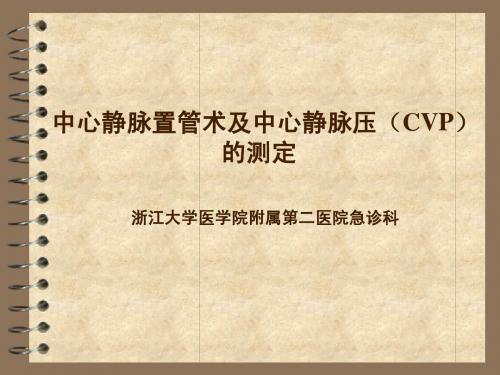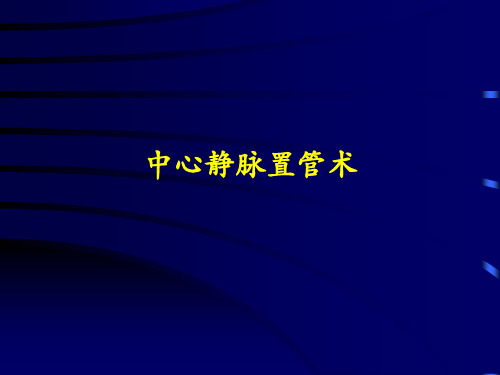中心静脉置管-锁骨下图谱
中心静脉穿刺置管术(颈内、锁骨下、股静脉)含解剖图谱 ppt课件

1681-4. Epub 2004 May 25.
35
CRBSI——致病菌
36
三腔CVC应当从哪个腔取血
在CRBSI的病例, 40%的CVC仅一个导管腔有细菌的明显定植
随机从一个导管腔留取血培养, 阴性结果的可能性为66% (2/3)
总体而言, 对于CRBSI病例, 随机从一个导管腔留取血培养, 阴性结果 可能性为40%
21
穿利多卡因 2ml b. 试穿,探明位置、方位和深度
22
穿刺置管
a.穿刺路径,保持负压 b.进入静脉,突破感,回血通畅,呈暗红色,
压力不高 c.置导丝,用力适当,无阻力,深浅合适,不
能用力外拔 d.外套管,捻转前进,扩管有度 e.沿导丝置导管
23
封管 回抽血顺畅,先以NS 5-10ml脉冲式
推入,再以肝素盐水1-2ml推入 固定 缝线 ,敷贴
24
注意事项
a. 进针深度: 一般1.5~3cm,肥胖者2~4cm b.注意病人体位和局部解剖标志 c.进针方向与角度不合适,静脉张力过低,
被推扁后贯穿 d.有回血,但导丝推进有困难,顶于对侧壁 e.导丝的刻度、弯头
导管局部感染发 (病/10率00导管留置 )日
15 13.15
10
5
0 股静脉
6.29 颈内静脉
1.81 锁骨下静脉
Lorente L, Villegas J, Martin MM, Jimenez A, Mora ML. Catheter-related infection in critically ill patients. Intensive Care Med. 2004 Aug; 30(8):
笨,没有学问无颜见爹娘 ……” • “太阳当空照,花儿对我笑,小鸟说早早早……”
中心静脉置管术及中心静脉压(CVP)的测定

图2:锁骨下静脉的解剖部位
锁骨下路
优点:临床应用最广泛的一种方式
• 穿刺部位为锁骨下方胸壁,该处较为平坦,可以进行满意的消毒 准备; • 穿刺导管易于固定,敷料不跨越关节,易于清洁和更换; • 不影响患者颈部和上肢的活动,敷料对患者是舒适的;
• 利于置管后护理;
• 只要操作者受过一定训练,本治疗方法是相对安全的。
锁骨下路
• 试穿确定锁骨下静脉的位置后,即可换用导针穿刺置管,导
针的穿刺方向与试探性穿刺相同,一旦进入锁骨下静脉的位 置后即可抽得大量回血,此时再轻轻推进0.1~0.2cm,使导针 的整个斜面在静脉腔内,并保持斜面向下,以利导管或导丝
推进。
• • • 令患者吸气后屏息,取下注射器,以一只手固定导针并以手 指轻抵针尾插孔,以免发生气栓或失血。 将导管或导丝自导针尾部插孔缓缓送入,使管端达上腔静脉, 退出导针。如用导丝,则将导管引入中心静脉后再退出导丝。 抽吸与导管连接的注射器,如回血通畅,说明管端位于静脉 内。
进针方法:
• 穿刺针与身体正中线呈45°角,与冠状面保持水平或稍向前呈 15°角,针尖指向胸锁关节,缓慢向前推进,且边进针边回抽, 一般进针2~3cm左右即可进入锁骨下静脉,直到有暗红色回血为 止。然后导针由原来的方向变为水平,以使导针与静脉的走向一 致。
图4:锁骨上穿刺途径
锁骨上路
基本操作:
颈静脉插入上腔静脉并原位固定。如锁骨下静脉置管。
隧道式(tunneled)指导管前端在上腔静脉,后半部
分在胸壁皮下潜行。如带涤纶套的Hickman导管。
输液港(port-cath)基本操作同隧道式,不同之处在
于需用手术方法将输液港放在前胸或腹部的皮下,应 用时将针头刺入输液港,建立中心静脉输液通道。
中心静脉穿刺之锁骨下入路(最适合新手哦!)ppt课件

•ቤተ መጻሕፍቲ ባይዱ
•
禁忌证
•躁动不安不易配合的患者 •呼吸急促而不能取平卧位的患者 •胸膜顶上升的肺气肿患者 •锁骨或第一肋骨骨折的患者 •穿刺部位皮肤细菌、真菌感染者 •穿刺静脉血栓形成者 •凝血功能障碍
应用解剖学基础-2
• 锁骨下静脉是腋静脉的延续,呈轻度向上
的弓形,长3~4cm,直径1~2cm,由第1肋 外缘行至胸锁关节的后方,在此与颈内静 脉相汇合形成头臂静脉,其汇合处向外上 方开放的角叫静脉角。近胸骨角约右侧, 两条头臂静脉汇合成上腔静脉。
应用解剖学基础-3
• 锁骨下静脉的前上方有锁骨与锁骨下肌;后方则
上腔静脉,锁骨中1/3段矢状切面观,胸膜 顶在锁骨下动脉的后下侧及锁骨下静脉的
后侧。
锁骨下静脉穿刺置管
• 大致解剖 • 穿刺步骤 • 消毒、铺巾、局麻 • 穿刺、扩张、置管 • 封管、固定
体位准备
• • • •
仰卧位 头低脚高位15o 肩背部垫高 头部转向对侧
体位准备
• 体姿参考 一般情况较好的病人取仰卧位,
应用解剖学基础-4
左侧较粗的胸导管及右侧较细的淋巴管 在靠近颈内静脉的交界处进入锁骨下静脉 上缘,右侧头臂静脉在胸骨柄的右缘下行, 与跨越胸骨柄后侧的左头臂静脉汇合。 • 左侧锁骨下静脉穿刺置管时需注意切勿损 伤胸导管,从而引起乳糜胸等严重并发症。
应用解剖学基础-5
在靠近胸骨角后侧,两侧头部静脉汇合成
穿刺前准备
• 带口罩、帽子、无菌手套 • 严格遵守无菌原则 • 消毒铺洞巾 • 深静脉导管
内注入NS将 空气排空 • 检查导引钢 丝有无弯折
穿刺点的选择
穿刺点的选择
• (锁骨上入路)穿刺点选在胸锁乳突肌锁
最新深静脉穿刺置管术(颈内、锁骨下、股静脉)含解剖图谱.ppt课件

-
33
操作方法
➢确定腹股沟韧带 ➢触及股动脉后,在腹股沟韧带下方1-2cm、股动 脉内侧 ➢旁开0.5-1cm进针,与皮肤夹角30-45°,针尖 指向脐 ➢Seldinger技术流程
-
34
中心静脉导管护理
• 1 保持导管通畅,观察输液速度,避免管路
打折及脱落。
-
13
置管深度 a.男13~15cm,女12~14cm,小儿5~8cm b.过深,心律失常、影响监测结果
胸像确认管的位置 主动脉弓水平
-
14
并发症---- 误穿动脉
常见于颈动脉及锁骨下动脉
原因:主要是由于穿刺操作不熟练, 解 剖 结 构 毗 邻 关 系 不清
表现:血色鲜红,喷出或快速流出
处理:a.立即拔针,指压5~10min,否则可发生血肿 b.若伴有胸膜刺破,胸膜腔负压作用,形成血胸, 肝素化、凝血功能障碍病人应特别谨慎
-
4
● 禁忌证
* 广泛上腔静脉系统血栓形成
* 穿刺局部有感染 * 凝血功能障碍 * 不合作,燥动不安的病人
-
5
-
6
颈内静脉穿刺置管术
-
7
右侧颈内静脉优于左侧
a. RIJV与无名静脉和上腔静脉几乎成一直线 b. 右侧胸膜顶低于左侧 c. 右侧无胸导管
-
8
穿刺步骤(seldinger法)
消毒、铺巾 局麻定位
• 明确的导管相关性血行性感染:
– 导管培养阳性(半定量或定量) – 拔除导管前外周血培养阳性 – 两者为相同微生物
• 可能的导管相关性血行性感染: 菌血症+
– 插管部位脓性分泌物 – 导管接头培养阳性 – 导管血培养分离出相当于外周血培养5倍的
2015深静脉穿刺置管术(颈内、锁骨下、股静脉)含解剖图谱

其他中心静脉置管方式
• 隧道式(tunneled)指导管前端在上腔静脉,后半部分 在胸壁皮下潜行。如带涤纶套的Hickman导管。 • 输液港(port-cath)基本操作同隧道式,不同之处在于 需用手术方法将输液港放在前胸或腹部的皮下,应用 时将针头刺入输液港,建立中心静脉输液通道。
JAMA 2001, 286: 700-7
每日评估留置导管的必要性
• 将评估拔除插管必要性作为每日检查目 标的一部分 • 记录留置导管的日期及时间, 以方便医生 进行决策
并发症----神经和淋巴管损伤
* 原因:颈内静脉穿刺进针太偏外侧, 损伤臂
丛神经
* 表现:上臂由触电样麻木感或酸胀或上臂抽动
* 处理:退出穿刺针,调整后重新穿刺或重选
在胸锁关节处与SCV汇合成无名静脉
右侧颈内静脉优于左侧
a. RIJV与无名静脉和上腔静脉几乎成一直线
b. 右侧胸膜顶低于左侧 c. 右侧无胸导管
穿 刺 法
定位
胸锁乳突肌三角的顶端作为穿刺点 约在环状软骨水平,颈动脉外侧 针干与皮肤呈45°角,直指同侧乳头
体位
去枕平卧,头转向对侧 肩背部垫一薄枕,取头低位10°-15°
导管局部感染发病率 导管留置日 (/1000 )
15
13.15
10 6.29 5 1.81 0 股静脉 颈内静脉 锁骨下静脉
Lorente L, Villegas J, Martin MM, Jimenez A, Mora ML. Catheter-related infection in critically ill patients. Intensive Care Med. 2004 Aug; 30(8): 1681-4. Epub 2004 May 25.
深静脉穿刺置管术(颈内、锁骨下、股静脉)含解剖图谱

并发症
气胸(%) 血胸(%) 感染(‰) 血栓形成(‰) 误穿动脉(%)
颈内静脉 <0.1-0.2
8.6 1.2-3
3
不同穿刺部位 锁骨下静脉 1.5-3.1 0.4-0.6 4 0-13 0.5
股静脉 -
15.3 8-34 6.25
异位风险
低风险
高风险
(穿过右心房, (上行至颈
至下腔静脉)
内静脉,
于长期留管或用于大静脉营养。
锁骨下静脉穿刺方法
• 锁骨下径路 • 锁骨上径路
锁骨下静脉穿刺置管(锁骨下路法)示意图
锁骨下静脉穿刺置管(锁骨下路法)示意图
锁骨下静脉穿刺置管(锁骨上路法)示意图
股静脉穿刺置管术
解剖特点
股静脉为髂外静脉的延续,在大腿根部腹股 沟韧带下方与股动脉同行于股血管鞘内,位于动 脉的内侧,在腹股沟韧带下1.5-2cm处有大隐静 脉汇入。由于此处股动脉搏动容易触及,定位标 志明确,与之伴行的股静脉直径较粗大,因此行 股静脉穿刺容易成功。
锁骨下颈内股静脉外周picc适应证治疗血液透析血浆臵换术监测picco禁忌证不合作燥动不安的病人准备工作准备工作股静脉需要平卧如何选择穿刺部位如何选择穿刺部位并发症不同穿刺部位颈内静脉锁骨下静脉股静脉气胸01021531感染86153血栓形成123013834误穿动脉05625异位风险低风险穿过右心房至下腔静脉高风险上行至颈内静脉甚至穿至对侧锁骨下静脉极低风险腰静脉丛选择哪个部位进行置管选择哪个部位进行置管icu股静脉和锁骨下静脉插管的rct股静脉插管组感染并发症更高
知识回顾 Knowledge Review
放映结束 感谢各位的批评指导!
谢 谢!
让我们共同进步
并发症----神经和淋巴管损伤
- 1、下载文档前请自行甄别文档内容的完整性,平台不提供额外的编辑、内容补充、找答案等附加服务。
- 2、"仅部分预览"的文档,不可在线预览部分如存在完整性等问题,可反馈申请退款(可完整预览的文档不适用该条件!)。
- 3、如文档侵犯您的权益,请联系客服反馈,我们会尽快为您处理(人工客服工作时间:9:00-18:30)。
26Central Venous Catheterization —Subclavian VeinDana A.V. Braner, M.D., Susanna Lai, M.P.H., Scott Eman, B.S.,and Ken Tegtmeyer, M.D.From the Department of Pediatrics, Ore-gon Health & Science University, Portland. Address reprint requests to Dr. Tegtmeyer at the Department of Pediatrics, Oregon Health & Science University, 707 SW Gaines St., MC: CDRC-P, Portland, OR 97239, or at tegtmeye@.N Engl J Med 2007;357:e26.Copyright © 2007 Massachusetts Medical Society.I n d I c a t I o n sCentral venous catheterization provides for the administration of caustic and criti-cal medications as well as allowing sampling of blood and measurement of central venous pressure. Recent evidence and Institute for Healthcare Improvement bun-dled guidelines1 suggest that the subclavian vein is the preferred choice for place-ment of a central venous catheter.c o n t r a I nd I c a t I o n sGeneral contraindications for placement of a central venous catheter include infec-tion of the area overlying the target vein and thrombosis of the target vein. Spe-cific contraindications to the subclavian approach include fracture of the ipsilateral clavicle or anterior proximal ribs, which can distort the anatomy and make place-ment difficult. Greater caution should be used when placing a central venous catheter in coagulopathic patients. The location of the artery (beneath the clavicle) makes application of direct pressure nearly impossible in attempts to control bleeding.E q u I p m E n tMost of the necessary equipment can be found in commercially available kits. These kits typically include skin-preparation solution and a drape, lidocaine, sterile gauze, non-Luer lock syringes, a scalpel, a catheter, a dilator, several needles, and a guide-wire. You will also need a sterile gown, sterile gloves, a surgical cap, a mask with a face shield, and drapes to cover the patient’s entire body. Flush solution is also not commonly found in the kits. Determine the catheter length and depth of placement by referring to the patient’s external landmarks. The tip of the catheter should reach the junction of the superior vena cava and the right atrium. Common catheters used range from 4-French catheters for infants to 7-French catheters for adults;11.5-French catheters may be used for dialysis. Because the risk of infection in-creases with an increasing number of lumens, a catheter with the fewest number of lumens required should be used.p r E p a r a t I o nExplain the procedure to the patient and obtain written informed consent. Wear a sterile gown and gloves, a mask with face shield, and a surgical cap. Examine the patient to be sure that there are no contraindications. Place the patient in the 15-degree Trendelenburg position, which will engorge the vein. If you place a rolled towel or similar object under the spine to help identify the patient’s external land-marks, be aware that propping the shoulder or turning the head has been shown to decrease the size of the vein on ultrasonography.2 Scrub the area thoroughly with chlorhexidine. Drape the area, covering the patient’s entire body.T h e ne w engl a nd jour na l o f medicinen engl j med 357; december 13, 2007eNext, identify anatomic landmarks, beginning with the middle third of the clavicle. Follow this laterally to the point where the clavicle deviates from the proximal ribs (Fig. 1). Just medial to this point, the subclavian vein and artery run just inferior to the clavicle. This is where most successful catheterization occurs. The insertion site should be somewhat remote from the clavicle, so that the path of the needle ultimately stays parallel to and just under the clavicle. Typically, the point of insertion is 2 cm lateral to and 2 cm caudal to the middle third of the clavicle (Fig. 2). Local anesthesia with 1 to 2 ml of 1 percent lidocaine or equiva-lent should be used in this area.u l t r a s o u n d G u I d a n c ESeveral recent articles suggest that ultrasonography can increase the likelihood of successful placement of a subclavian catheter, despite the presence of bony land-marks.3,4 Because of the greater difficulty in identifying the vein by compression, Doppler flow should be used to distinguish between the artery and the vein.t h E p r o c E d u r EStarting 2 cm lateral to the bend of the clavicle and approximately 2 cm caudal, insert the catheterization needle through the skin at a 30-degree angle toward the sternal notch. Place a finger of your nondominant hand in the sternal notch to help find the landmark. Once the needle is under the skin, lower the needle and syringe to run parallel to but beneath (posterior to) the clavicle (Fig. 3). Access to the vein typically occurs just beneath the clavicle, but it may involve a depth of several cen-timeters under the skin.Once you have obtained venous access, carefully stabilize the needle and re-move the syringe. Introduce the J-tipped end of the guidewire into the needle. The wire should thread easily and without resistance until well beyond the end of the needle. If you notice ectopic cardiac beats on the monitor, pull the wire back until the ectopic beats disappear. Then remove the needle, leaving the wire in place. Maintain control of the wire. A small, 1-to-2-mm incision should be made in the skin at the insertion point to facilitate dilator passage. Advance the dilator over the wire into and through the skin and then into the vessel. Once the vessel is dilated, the dilator can be removed. Use a gauze pad to control increased bleeding, which usually occurs after dilation. Advance the line over the guidewire, maintain-ing control of the wire before passing the catheter into the skin. Remove the guidewire, check for blood return from all ports, flush all ports, and secure the catheter in place. Apply a sterile dressing before removing the drapes (Fig. 4).c o m p l I c a t I o n sSpecific complications associated temporally with placement of a subclavian line include hemothorax and pneumothorax, air embolism, inadvertent arterial punc-ture, and aortic perforation. Obtain a chest radiograph after placement to assess for complications and for correct placement of the catheter. Common malplacement locations include placement transverse to the contralateral subclavian vein, retro-grade into the ipsilateral internal jugular vein, or potentially the contralateral inter-nal jugular vein.Longer-term complications include thrombosis of the vein and infection. Data suggest that subclavian placement mitigates but does not eliminate the risk of infection. Adherence to the Institute for Healthcare Improvement guidelines, in-cluding the use of proper hand hygiene, the use of maximal barrier precautions during placement, the use of chlorhexidine skin antisepsis, and daily review of need for the catheter, will help to decrease the risk of infection.1No potential conflict of interest relevant to this article was reported.ReferencesImplement the central line bundle. Cambridge, MA: Institute for Healthcare Improvement. (Accessed November 16, 2007, at /ihi/topics/ criticalcare/intensivecare/changes/ implementthecentrallinebundle.htm.) Fortune JB, Feustel P. Effect of patient position on size and location of the sub-clavian vein for percutaneous puncture. Arch Surg 2003;138:996-1000.Orihashi K, Imai K, Sato K, Hama-moto M, Okada K, Sueda T. Extrathoracic subclavian venipuncture under ultrasound guidance. Circ J 2005;69:1111-5.Pirotte T, Veyckemans F. Ultrasound-guided subclavian vein cannulation in in-fants and children: a novel approach. Br J Anaesth 2007;98:509-14.Copyright © 2007 Massachusetts Medical Society. 1.2.3.4.Figure 1.Anatomic Landmarks. Figure 2.Point of Insertion.Figure 3.Placement of the Needle. Figure 4. Application of the Dressing.CENTRAL VENOUS CATHETERIZATION — SUBCLAVIAN VEIN n engl j med 357; december 13, 2007。
